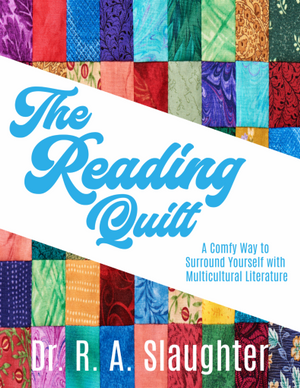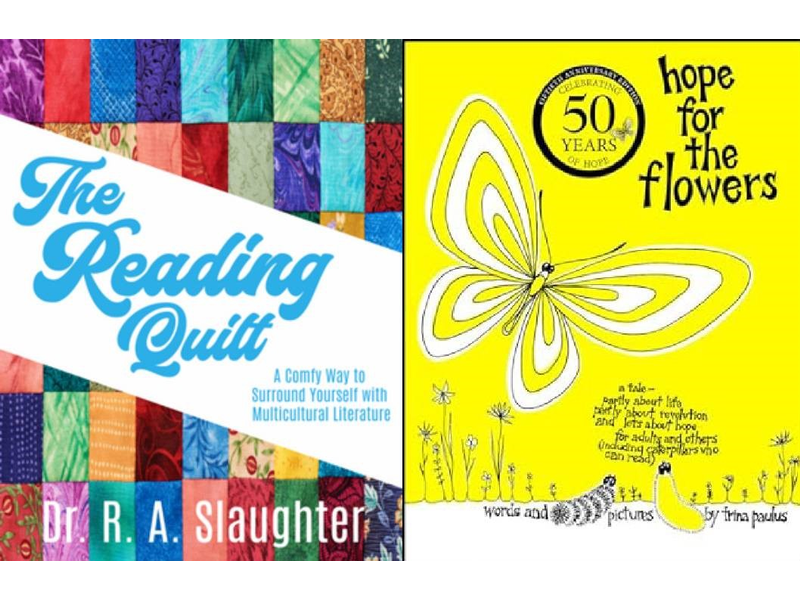I would win the argument that humans are not that much different from butterflies. Here is why: In the quest to find the meaning of life, a person must become introspective and brave.
After a time of introspection and stillness, a metamorphosis is the reward. The metamorphosis, which is often centered upon faith, is the prize for an arduous journey, one that is often lonely and scary. On the journey, one may become fatigued, and in the effort to avoid discomfort in the time of self-discovery, a person may decide to busy themselves with the minutiae of social drama.

Each month “The Reading Quilt” provides a short review of a book that a teacher may use to spark conversations about culture and race, along with a learning activity that may help students understand human behavior. Using the acronym QUILT, the review offers readers information about the Quality of writing, Universal theme, Imaginative plot, a mini Lesson plan, and Talking points that stem from the book’s premise. This month’s selection is a book titled Hope for the Flowers written and illustrated by Trina Paulus (Paulist Press, 1973). Now celebrating the book’s 50 year anniversary, Trina says “ I am blessed and humbled that for over half a century Yellow and Stripe have been crawling across the globe, reaching hearts and changing lives. May the transformation of these two caterpillars inspire our own.”
Trina’s book is a hugely popular allegory that has stood the test of time because the book’s theme resonates so loudly with its readers. Yellow and Stripe, the two main characters, are the hero caterpillars that make this timeless fable come alive. In the book, the larva friends are in love, and lean on each other for support as they make decisions that will affect their future together.

Image: Trina Paulus. Source: trinapaulus.com
Quality of Writing: Trina opens the book with a personal letter to her readers which pulls the reader into what seems like a personal relationship with the book’s elementary pencil drawings and handwritten font. In the letter, Trina thanks her readers for taking the journey of Stripes and Yellow to witness “a tale of a caterpillar who has trouble becoming what he really is. It’s like myself– like us.” Signed with “Love, Trina,” the chapter book is dedicated to Trina’s father. In seven chapters, Trina begins the fable with the words that often bring young readers comfort “Once upon a time.” It is the phrase that introduces the readers to the birth of Stripe, who hatches from his egg before embarking on an insightful journey. Trina does an excellent job of writing the book from Stripe’s point of view, who is actually a baby in Chapter 1. However, she makes the allegorical message in the first chapter very obvious: There is more to life than what is right in front of our eyes.
Universal Theme: While Stripe gorges on leaves, Stripe begins to yearn for a life more fulfilling. Bored with the daily doldrums of dirt and leaves, he says to himself, “There must be more to life than just eating and getting bigger.” When he discovers the sky, he decides that he will try to get to the clouds. Once he decided to leave his comfort zone in the search for a more meaningful life, he came across an army of caterpillars who had the same idea.
Imaginative Plot: Stripe was dismayed when he realized that the caterpillars were only interested in finding treats at the ground level, but Stripe had outgrown grass, dirt, holes, and tiny bugs. His life takes a drastic turn when he finds a group of crawlers who are hurriedly moving to an unknown destination. These “crawlers were really crawling.” Upon investigation, Stripe could see the crawlers’ target: An ominous column or “caterpillar pillar” rising high into the clouds. This sight intrigues him, and he blindly follows the crowd. While feverishly climbing the tower of hot caterpillars stepping on his peers to get ahead, he made a comment in exasperation that caught the attention of a yellow caterpillar whose tiny body was nearly crushed under the weight of the bristly insects. Once the two caterpillars meet, they decide to investigate the curious “caterpillar pillar” a little more closely.
Lesson Plan: Trina’s book, which has been translated into more than a dozen languages including Korean, Chinese, Japanese, Kurdish, Thai, Hebrew, Arabic, Turkish, and Swahili, was also adapted into a two-act musical written by Filipino composer Ariel Escasa. This book is the perfect opportunity for students to learn the process of turning a book into a play. Students could study the example of Alice Walker’s book The Color Purple. “The Color Purple has been adapted for film, then for Broadway, then revived on Broadway, and then the Broadway adaptation was itself brought to movie theaters in 2023.” Harper Lee’s novel To Kill a Mockingbird, published in 1960, is another example of a book adapted into a play in 2018.
Talking Points: When thinking about the book’s theme, the students could journal their answers to existential questions. A few examples are posted below:
- What is the meaning of life?
- What are some ways to see meaning in your life?
- What are the qualities of a good friend?

Dr. R. A. Slaughter’s (Doc) textbooks Turning the Page: The Ultimate Guide for Teachers to Multicultural Literature, and Turning the Page: A Guide to Securing Multicultural Literature for Schools, both published by Rowman & Littlefield and available in all bookstores, have brought Doc global recognition. Doc’s lecture on “Beating the Book Ban” is often met with standing ovations. For more information, log onto DrRachelSlaughter.info or check out “The Reading Quilt ” talk show, every Monday, at 3:30 pm on Philly Cam.





